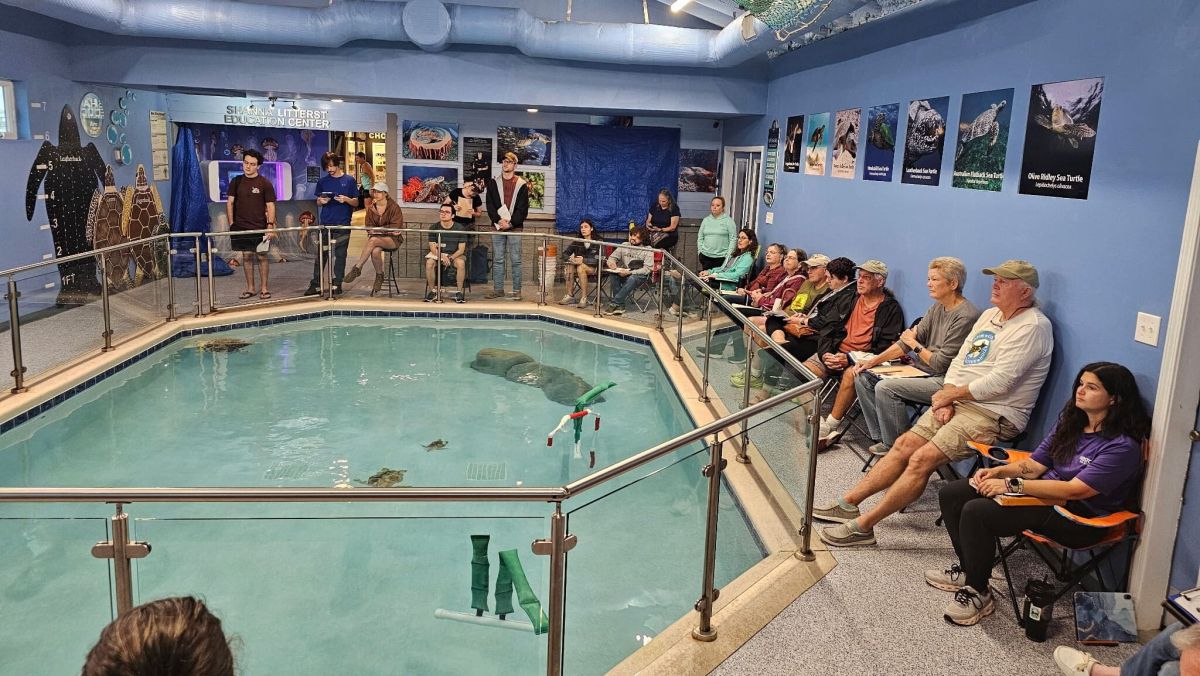Volunteers interested in terrapin tracking for Panhandle project

The Panhandle Terrapin Project is a citizen science project which monitors and surveys diamondback terrapins in the Florida Panhandle. The volunteer training at NBSTCC is one of four such training courses across four counties involved in the project. There are volunteer teams in Escambia, Santa Rosa, Okaloosa and Baldwin (AL) counties.
“The aim is to get a volunteer on the terrapin nesting beaches at least once a week from April 1 to the end of June,” said Rick O’Connor, a Florida Sea Grant agent overseeing the project. “The more volunteers we have, the more coverage we get, the better data we get. The more volunteers the better.”
O’Connor said he anticipates roughly 50-75% of those who show up to training sessions will become volunteers.
The diamondback terrapin, which is native to estuaries and other brackish waters along the coastlines of America’s Atlantic seaboard and Gulf states, was once thought to be non-existent in Northwest Florida. According to O’Connor, the project started in 2005 to prove whether terrapins were in the Panhandle and to collect data on the terrapin population.
O’Connor said the focus now is on understanding their status.
“How are they doing? Are their numbers increasing, decreasing? That kind of thing,” O’Connor said. “We are also looking at things like movement, habitat choice… we are learning some new things about them.”

Terrapins tend to have good “site fidelity,” meaning the animals return to nest along the same beaches year after year. Despite this tendency, O’Connor said some recent data has shown some decline in population, but he isn’t sure whether terrapins are moving to new locations.
“That is part of what these (volunteers) are going to try and help us figure out,” O’Connor said. “With the tagging that we do, we can tell if individual (terrapins) have left point A and are now nesting at point B. We are still seeing lots of terrapins, so I think there is movement going on.”
The project is organized through county coordinators, who help funnel information and data back and forth between O’Connor and those regularly surveying beaches. In Santa Rosa County, Rachael Stephenson and Elba Cardona are the coordinators.
Members of the terrapin project teams are coordinated so at least one volunteer surveys the primary beaches at least once a week and secondary beaches are surveyed as often as possible. Volunteers are trained in how to conduct beach surveys and how to measure and/or tag captured terrapins.
To find the terrapins, O’Connor said, volunteers will look for tracks or dug up nests with eggs laying around. If they find a terrapin itself, then they will catch it, weigh it, measure its shell size and tag it before release.
Currently, O’Connor said, they don’t have an accurate count of how many diamondback terrapins are in the area. To do that, O’Connor said they would need to do a mark-recapture study, in which you need to capture a tremendous number of turtles for an accurate estimate.
“We are doing what we call a ‘relative abundance’,” O’Connor said. “We know there is roughly somewhere between here and here. In some locations, we’ve estimated somewhere around 50 to 70 terrapins. Other locations, its 10 to 20 terrapins. I am also keeping track of how frequently they are seen.”
O’Connor said he also helps with terrapin science in places like Port St. Joe and Wakulla County. According to O’Connor, part of Florida Sea Grant’s mission is to restore and promote healthy bays and estuaries. He said if they see more terrapins, they will know they’re on the right track.
If you find a terrapin or a nesting area, contact Rick O’Connor at roc1@ufl.edu or Navarre Beach Sea Turtle Conservation Center at (850) 684-3347.







